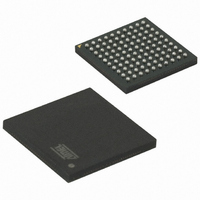AT91SAM7XC512-CU Atmel, AT91SAM7XC512-CU Datasheet - Page 458

AT91SAM7XC512-CU
Manufacturer Part Number
AT91SAM7XC512-CU
Description
MCU ARM 512K HS FLASH 100-TFBGA
Manufacturer
Atmel
Series
AT91SAMr
Specifications of AT91SAM7XC512-CU
Core Processor
ARM7
Core Size
16/32-Bit
Speed
55MHz
Connectivity
CAN, Ethernet, I²C, SPI, SSC, UART/USART, USB
Peripherals
Brown-out Detect/Reset, DMA, POR, PWM, WDT
Number Of I /o
62
Program Memory Size
512KB (512K x 8)
Program Memory Type
FLASH
Ram Size
128K x 8
Voltage - Supply (vcc/vdd)
1.65 V ~ 1.95 V
Data Converters
A/D 8x10b
Oscillator Type
Internal
Operating Temperature
-40°C ~ 85°C
Package / Case
100-TFBGA
Processor Series
AT91SAMx
Core
ARM7TDMI
Data Bus Width
32 bit
Data Ram Size
128 KB
Interface Type
MII, SPI, TWI
Maximum Clock Frequency
55 MHz
Number Of Programmable I/os
62
Number Of Timers
3
Maximum Operating Temperature
+ 85 C
Mounting Style
SMD/SMT
3rd Party Development Tools
JTRACE-ARM-2M, KSK-AT91SAM7X-PL, MDK-ARM, RL-ARM, ULINK2
Development Tools By Supplier
AT91SAM-ICE, AT91-ISP, AT91SAM7XC-EK
Minimum Operating Temperature
- 40 C
On-chip Adc
10 bit, 8 Channel
For Use With
AT91SAM-ICE - EMULATOR FOR AT91 ARM7/ARM9AT91SAM7XC-EK - KIT EVAL FOR AT91SAM7XC256/128
Lead Free Status / RoHS Status
Lead free / RoHS Compliant
Eeprom Size
-
Lead Free Status / Rohs Status
Lead free / RoHS Compliant
Available stocks
Company
Part Number
Manufacturer
Quantity
Price
- Current page: 458 of 727
- Download datasheet (11Mb)
Figure 34-6. Data IN Transfer for Non Ping-pong Endpoint
458
USB Bus Packets
TXPKTRDY Flag
(UDP_CSRx)
TXCOMP Flag
(UDP_CSRx)
FIFO (DPR)
Content
Using Endpoints With Ping-pong Attribute
AT91SAM7XC512/256/128 Preliminary
Set by the firmware
Data IN
PID
Prevous Data IN TX
Data IN 1
Interrupt Pending
The use of an endpoint with ping-pong attributes is necessary during isochronous transfer. This
also allows handling the maximum bandwidth defined in the USB specification during bulk trans-
fer. To be able to guarantee a constant or the maximum bandwidth, the microcontroller must
prepare the next data payload to be sent while the current one is being sent by the USB device.
Thus two banks of memory are used. While one is available for the microcontroller, the other
one is locked by the USB device.
Figure 34-7. Bank Swapping Data IN Transfer for Ping-pong Endpoints
Cleared by Hw
Data IN 1
Microcontroller
1 st Data Payload
2 nd Data Payload
3 rd Data Payload
DPR access by the firmware
ACK
PID
Load In Progress
Set by the firmware
Microcontroller Load Data in FIFO
Data IN
PID
Bank 0
Endpoint 1
Bank 1
Endpoint 1
Bank 0
Endpoint 1
Write
NAK
PID
Cleared by Firmware
USB Device
Data IN
PID
DPR access by the hardware
Bank 0
Endpoint 1
Bank 1
Endpoint 1
Bank 0
Endpoint 1
Read
Read and Write at the Same Time
Data is Sent on USB Bus
Data IN 2
Payload in FIFO
Data IN 2
USB Bus
Cleared by Hw
2 nd Data Payload
3 rd Data Payload
1 st Data Payload
Data IN Packet
Data IN Packet
Data IN Packet
6209F–ATARM–17-Feb-09
ACK
PID
Cleared by
Firmware
Interrupt
Pending
Related parts for AT91SAM7XC512-CU
Image
Part Number
Description
Manufacturer
Datasheet
Request
R

Part Number:
Description:
KIT EVAL FOR AT91SAM7XC256/128
Manufacturer:
Atmel
Datasheet:

Part Number:
Description:
KIT EVAL FOR AT91SAM7X256/128
Manufacturer:
Atmel
Datasheet:

Part Number:
Description:
MCU, MPU & DSP Development Tools KICKSTART KIT ATMEL AT91SAM7X
Manufacturer:
IAR Systems

Part Number:
Description:
MCU ARM9 64K SRAM 144-LFBGA
Manufacturer:
Atmel
Datasheet:

Part Number:
Description:
IC ARM7 MCU FLASH 256K 100LQFP
Manufacturer:
Atmel
Datasheet:

Part Number:
Description:
IC ARM9 MPU 217-LFBGA
Manufacturer:
Atmel
Datasheet:

Part Number:
Description:
MCU ARM9 ULTRA LOW PWR 217-LFBGA
Manufacturer:
Atmel
Datasheet:

Part Number:
Description:
MCU ARM9 324-TFBGA
Manufacturer:
Atmel
Datasheet:

Part Number:
Description:
IC MCU ARM9 SAMPLING 217CBGA
Manufacturer:
Atmel
Datasheet:

Part Number:
Description:
IC ARM9 MCU 217-LFBGA
Manufacturer:
Atmel
Datasheet:

Part Number:
Description:
IC ARM9 MCU 208-PQFP
Manufacturer:
Atmel
Datasheet:

Part Number:
Description:
MCU ARM 512K HS FLASH 100-LQFP
Manufacturer:
Atmel
Datasheet:

Part Number:
Description:
MCU ARM 512K HS FLASH 100-TFBGA
Manufacturer:
Atmel
Datasheet:

Part Number:
Description:
IC ARM9 MCU 200 MHZ 324-TFBGA
Manufacturer:
Atmel
Datasheet:

Part Number:
Description:
IC ARM MCU 16BIT 128K 256BGA
Manufacturer:
Atmel
Datasheet:











